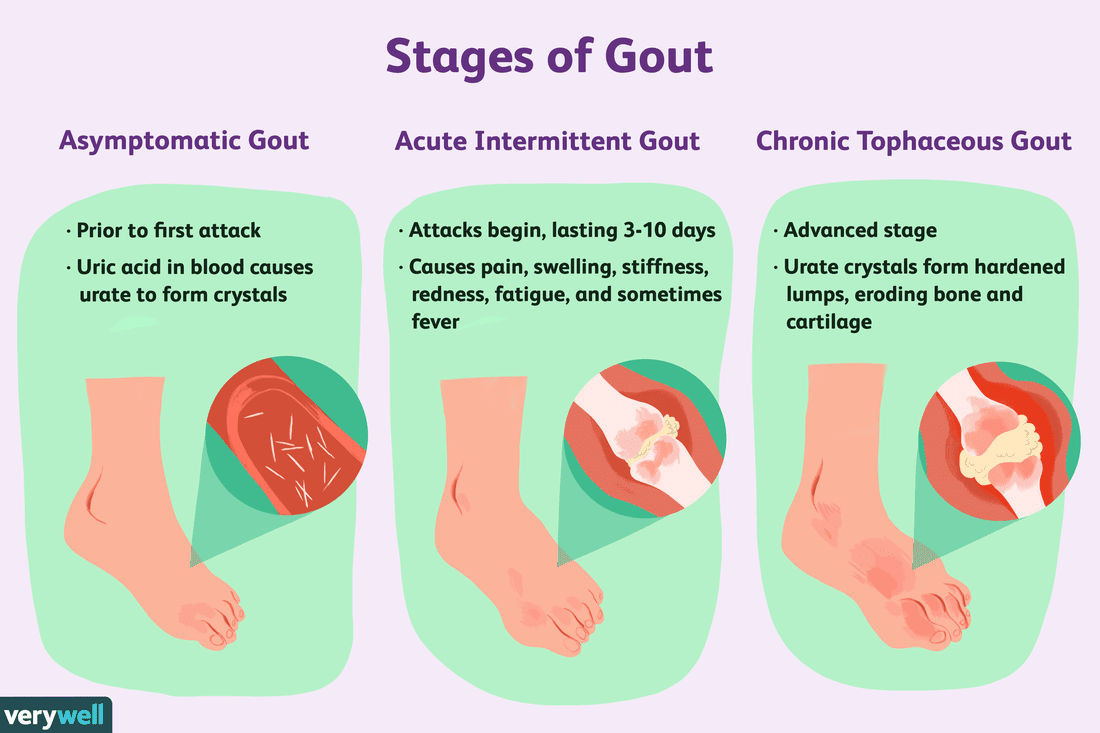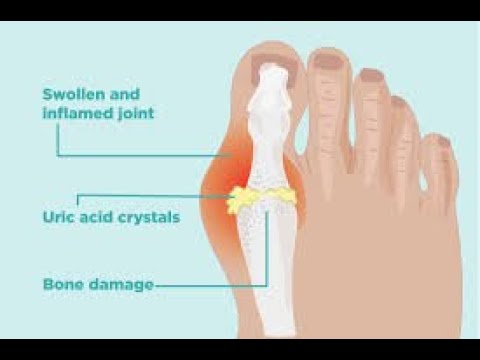
People suffering from gout should visit a doctor if the pain worsens or if a fever is present. The aim of treatment is to reduce the amount of uric acid in the body. Having too much uric acid in the body will eventually form crystals in the joints. These crystals will damage the joint. If the condition is not treated promptly, it can lead to kidney stones. In severe cases, it can even lead to amputation.
The first and most common joint to be affected by gout is the big toe, but the symptoms can affect any joint. The painful symptoms usually occur within four to twelve hours after an attack, but lingering discomfort can persist for days or weeks after the onset of an acute attack. During the first attack, the affected joint is swollen and tender and the surrounding skin becomes inflamed and red. It's common for gout attacks to restrict a person's range of motion.
Acute gout attacks are often treated with nonsteroidal anti-inflammatory drugs, or NSAIDs, which are a class of medicines that reduce uric acid levels in the body. These medications are taken for up to two weeks to alleviate the symptoms of acute gout. Acute gout attacks can occur anywhere in the body and will typically occur in the big toe. They will generally be most painful in the first few hours, but later on, the symptoms will progress to affect more joints.
NSAIDs are commonly used to treat gout. These drugs relieve inflammation in the joints and reduce tissue pain. NSAIDs are effective for most acute gout attacks and are usually prescribed in high doses. Although they may cause stomach upset, they are safe and effective when taken regularly for a short period of time. However, there are people with certain medical conditions who should not take NSAIDs.

The first step in treating gout is to determine the cause of your condition. The disease usually begins in the big toe, but can develop in any joint. Acute attacks of gout usually last between four and 12 hours, but lingering discomfort will continue for days or even weeks. Affected joints will be warm, swollen, and painful. Symptoms include swelling and burning in joints. Some of these attacks can result in limited range of motion, limiting activity.
NSAIDs, also known as NSAIDs, are an effective treatment for acute gout. They can reduce the level of uric acid in the body. NSAIDs may also affect other joints, including the lungs and heart. A doctor may prescribe medication if these medications are ineffective or poorly tolerated by patients. NSAIDs can also be taken long-term. If you tolerate the medication, you may want to try other treatment options listed on the health website vietlifemedical.com.
In severe cases, NSAIDs are an effective treatment for gout. They reduce pain and inflammation caused by crystals in the joint. In severe cases, NSAIDs can raise blood pressure and cause stomach or kidney problems. They may also be prescribed for a shorter period. Some people cannot take these drugs because of the risk of kidney or liver damage. This can be life-threatening. The best treatment for gout is a combination of NSAIDs and lifestyle changes.
Acute attacks of gout can occur suddenly. They usually last several hours and can be painful. The doctor will be able to determine whether there is a trigger for gout. If this is the case, the patient may take medications to reduce the level of uric acid in the body. These treatments may include NSAIDs and pain medications. The doctor will need to prescribe a medicine that will reduce the amount of uric acid in the body.
Symptoms of gout may vary from person to person. Acute gout attack can occur anywhere on the body. It can be painful and debilitating for some people. It's important to see a doctor as soon as possible for a proper diagnosis. A rheumatologist will have a specialized microscope with a polarizing attachment for viewing uric acid crystals. A doctor will also be able to perform a uric acid test.